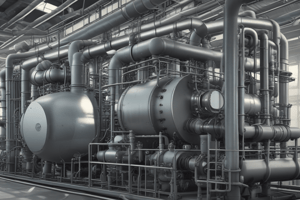Podcast
Questions and Answers
Explain the function of a boiler in the process of steam generation.
Explain the function of a boiler in the process of steam generation.
The function of a boiler is to transfer the heat generated from the chemical energy in the fuel to the contained water in the most efficient manner to generate high-quality steam for plant use.
What are the methods through which heat is transferred to the boiler water in the boiler furnace?
What are the methods through which heat is transferred to the boiler water in the boiler furnace?
Heat is transferred to the boiler water through radiation, conduction, and convection in the boiler furnace.
List three plant uses for the steam generated in the boiler.
List three plant uses for the steam generated in the boiler.
The steam generated in the boiler is used for turbine drive for electric generating equipment, heating for direct contact for equipment and comfort, and process for direct contact with products.
Why are only specific impurities eliminated from the water used in boilers for steam generation?
Why are only specific impurities eliminated from the water used in boilers for steam generation?
What is the recommended hardness level for boiler-feed water?
What is the recommended hardness level for boiler-feed water?
What is the primary function of a boiler in the process of steam generation?
What is the primary function of a boiler in the process of steam generation?
How is heat primarily transferred to the boiler water in the boiler furnace?
How is heat primarily transferred to the boiler water in the boiler furnace?
What is the main purpose of generating steam in a boiler for industrial and power house use?
What is the main purpose of generating steam in a boiler for industrial and power house use?
Why are only specific impurities eliminated or controlled in boiler-feed water?
Why are only specific impurities eliminated or controlled in boiler-feed water?
What should be the hardness level of boiler-feed water according to the recommended composition?
What should be the hardness level of boiler-feed water according to the recommended composition?
Flashcards are hidden until you start studying
Study Notes
Boiler Function and Steam Generation
- Boilers are essential for generating steam, a crucial energy source in various industries.
- Steam is produced by heating water to its boiling point, which is achieved within a boiler.
- The primary function of a boiler is to transfer heat from the combustion process to the water, converting it into steam.
Heat Transfer in Boiler Furnaces
- Heat is primarily transferred to the boiler water through three methods:
- Conduction: Heat is transferred through direct contact between the hot furnace walls and the boiler water.
- Convection: Heat is transferred via the movement of heated water, carrying thermal energy to cooler areas.
- Radiation: Heat is transmitted through electromagnetic waves from the flames and furnace walls to the water.
Applications of Steam
- Steam generated in boilers finds diverse uses in various industries:
- Power Generation: Steam is used to drive turbines, generating electricity.
- Industrial Processes: Steam plays a vital role in numerous industrial processes like heating, drying, and sterilization.
- Heating and Cooling: Steam provides heating solutions and can also be utilized for cooling applications.
Water Treatment for Boilers
- Only specific impurities are removed from boiler feedwater to avoid operational issues and maintain boiler efficiency.
- Excessive mineral content can lead to scaling and corrosion, reducing boiler efficiency and lifespan.
- However, all impurities cannot be removed due to cost and practical limitations.
Hardness Level for Boiler Feedwater
- Recommended hardness levels for boiler feedwater vary based on boiler pressure and type.
- General guidelines suggest a hardness level of less than 1 ppm (parts per million) for high-pressure boilers.
- Lower hardness levels are preferred to minimize the formation of scale and corrosion.
Studying That Suits You
Use AI to generate personalized quizzes and flashcards to suit your learning preferences.




